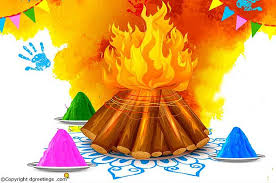Holi
The holi festival is celebrate in march month or in Falgun month according to hindu calendar in all India.

The festival of Holi like all the other Indian festivals is steeped in history and legends, the most popular one being the legend of Prahlada, Hiranyakashipu and Holika. Hiranyakashipu, the demon king was granted a boon owing to which it was nearly impossible to kill him. His arrogance reached new heights and he challenged the authority of the Gods itself. Prahlada, son of Hiranyakashipu was a staunch believer and was chosen by Lord Vishnu to put an end to the atrocities of his father.
When the knowledge of it reached the ears of Hiranyakashipu, he devised several strategies to kill his own son. When nothing worked, he made Prahlada sit on the lap of his sister Holika who entered fire with Prahlada in her lap as she could not be burnt as per a boon granted to her. But instead of Prahlada, it was Holika who was burnt to ashes and Prahlada remained completely unharmed. The festival is celebrated to mark the victory of good over evil and burning of Holika.
The other popular legends associated with the festival are the legend of Kamdeva and the legend of Krishna and Radha.
The festival of Holi is celebrated all across the country with a lot of enthusiasm and gaiety. Different names are given to the festival in different parts of the country. The festival is popular as Phagwa in Bihar, Dol Purnima in Bengal and Hola Mahalla in Punjab. Some of the rituals common to the celebration of the festival in all parts of the country are: Splash of colours, Preparation of delicacies and sweets especially ‘Gujiyas’, consumption of Bhaang and burning the Holi bonfire.
Some of the other popular Holi celebrations include the Lath Maar Holi of Barsana in Uttar Pradesh where women are given the rare opportunity to shoo away men singing provocative songs with sticks. Holi in Bengal is celebrated by singing classical songs particular to the occasion and playing several musical instruments. In Punjab, Sikhs demonstrate their skills in martial arts at the occasion. Besides, processions with Jhankis (floats) are held in several parts of the country to mark the occasion.
Significance: It signifies the victory of good (Prince Prahlad) over evil (Holika) and the arrival of spring
